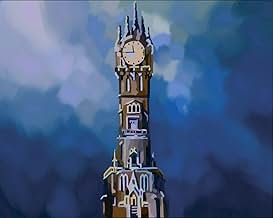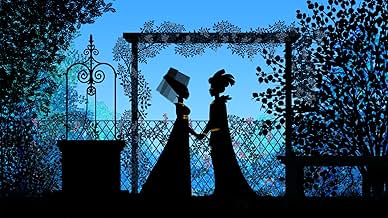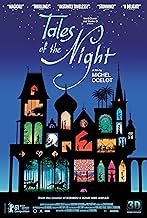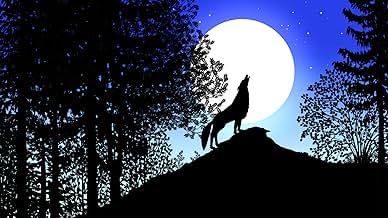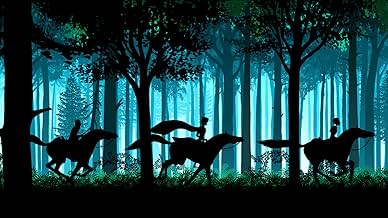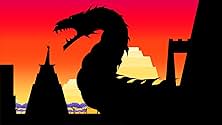CALIFICACIÓN DE IMDb
6.9/10
1.8 k
TU CALIFICACIÓN
Agrega una trama en tu idiomaTales of the Night weaves together six exotic fables each unfolding in a unique locale, from Tibet, to medieval Europe, to the Land of the Dead. From the imagination of internationally renow... Leer todoTales of the Night weaves together six exotic fables each unfolding in a unique locale, from Tibet, to medieval Europe, to the Land of the Dead. From the imagination of internationally renowned animator Michel Ocelot.Tales of the Night weaves together six exotic fables each unfolding in a unique locale, from Tibet, to medieval Europe, to the Land of the Dead. From the imagination of internationally renowned animator Michel Ocelot.
- Dirección
- Guionista
- Elenco
- Premios
- 1 nominación en total
- Dirección
- Guionista
- Todo el elenco y el equipo
- Producción, taquilla y más en IMDbPro
Opiniones destacadas
Nice framing story of an old man and two younger aspiring directors who get together in an abandoned Parisian cinema to brainstorm and create. Interestingly, the creative process is not entirely clear: Are the two children acting? Providing a model for the old man to animate? Regardless, the six stories all transpire in "exotic" locales (including medieval Europe), which appealed a lot to my kids. We've now watched it twice, and they loved it both times. The silhouette animation, with its rich colors, is beautiful and surprisingly complex. Sienna's favorite story was the Aztec-inspired City of Gold and its snake protector/attacker, Sebastian's was the Tibetan story of the talking horse and the boy who never lied, and mine was the wizard and the architect's son.
From the director of Kirikou and the Sorceress, this animated film, done in a CGI shadow puppet style, is about a brother and sister who, along with an elderly man they know, concoct movie scenarios. Six different fairy tale scenarios are illustrated. I've never actually seen any of the Kirikou films, but I've heard good things. This film doesn't inspire me to check anything else by Ocelot out. The visuals are quite gorgeous, don't get me wrong, but the screen writing is flat, boring and downright regressive. Five of the six stories have the boy as the hero saving the girl, who is a damsel in distress. The sixth one isn't particularly progressive, either. The version I watched on Netflix was dubbed in English by a group of British actors who are particularly boring. Skip it.
If someone were to ask if I recommended Tales of the Night, the answer would be yes. It is a very simple film and doesn't break new ground from a thematic perspective. That doesn't matter because so much of the movie is beautifully done. The animation makes for a visual treat, not just the shadowy silhouettes for the character designs and the drama being conveyed but also the backgrounds with the gloriously vivid colours. The music doesn't overbear what's happening in the six featured stories, as well as being sensitive, lushly orchestrated and lyrical it allows the stories to speak for themselves. And speak for themselves they do, the moralising, positive messaging and lessons do not preach and are ones that anybody young and old can relate fully to as well as being important values. There is an Aesop's Fables feel at times especially in The Werewolf, not that that it is an issue, far from it. And the stories do have great atmosphere while never trying to be too complicated, The Boy Who Never Lied and Boy Tam-Tam are somewhat graphic yet magical. Personal favourite has to go to The Doe Girl and the Architect's Son, which contains the best animation of the film and is quite poignant. The characters don't break new ground either but they have a real charm to them and carry their stories very well. In fact, if there was anything that wasn't quite right it was the old-theatre-and-re-enacting links, not a bad idea but at times clumsily handled. Other than that, Tales of the Night is a very good film indeed. 9/10 Bethany Cox
Ocelot's toons have always had the unfamiliar (African) imagery working for them. Their naive plot lines have been both an attraction and a limitation.
This episode film, framed with sessions in the re-voicing studio - where an owl is perched on the desk - are not a step towards more traditional work.
The recognisable Ocelot style is here mixed with a bit of Lotte Reiniger and boosted by a fascinating use of Three D, which spaces the arms and eyes of the outline crowd at different distances from the viewer, among other effects. Was it ever shown anywhere else but the Paris Champs Elysses that way? Whether the makers can take this style further and how it will go down with the tot audiences, I've seen cheer the Kirikou films, has yet to be seen.
This episode film, framed with sessions in the re-voicing studio - where an owl is perched on the desk - are not a step towards more traditional work.
The recognisable Ocelot style is here mixed with a bit of Lotte Reiniger and boosted by a fascinating use of Three D, which spaces the arms and eyes of the outline crowd at different distances from the viewer, among other effects. Was it ever shown anywhere else but the Paris Champs Elysses that way? Whether the makers can take this style further and how it will go down with the tot audiences, I've seen cheer the Kirikou films, has yet to be seen.
I did love the animation that the movie was doing. You don't see this style done a lot in this age. I feel it's good to have these choices as animation is an art form and there should be a variety of it other than just the mainstream 3D stuff every animated movie is doing now.
thought the animation lends to the fairy tales that make up the movie (it was almost like opening up a book than watching a movie) the fairy tales themselves were just OK. It may have been the English translation as the movie is originally in french, but I felt the movie was lacking what you would expect in the art of telling fairy tales. like a voice over narration that explains what the characters are going was absent. That may have given the stories just a little more dramatic poise
I did like the concept that connected the stories together about an old man who was told he's too old to make movies and two kids who were told they are too young, team up to make movies in an old run down cinema. Interesting enough, their story was told with a voice over narration.
Overall, I like the movie a lot it was beautiful to see.
thought the animation lends to the fairy tales that make up the movie (it was almost like opening up a book than watching a movie) the fairy tales themselves were just OK. It may have been the English translation as the movie is originally in french, but I felt the movie was lacking what you would expect in the art of telling fairy tales. like a voice over narration that explains what the characters are going was absent. That may have given the stories just a little more dramatic poise
I did like the concept that connected the stories together about an old man who was told he's too old to make movies and two kids who were told they are too young, team up to make movies in an old run down cinema. Interesting enough, their story was told with a voice over narration.
Overall, I like the movie a lot it was beautiful to see.
¿Sabías que…?
- TriviaThis film is made up of varied short stories using Michel Ocelot's "silhouette animation" techniques.
- ConexionesEdited from Dragones y princesas: L'Élue de la Ville d'or (2010)
Selecciones populares
Inicia sesión para calificar y agrega a la lista de videos para obtener recomendaciones personalizadas
- How long is Tales of the Night?Con tecnología de Alexa
Detalles
Taquilla
- Total en EE. UU. y Canadá
- USD 10,975
- Fin de semana de estreno en EE. UU. y Canadá
- USD 7,154
- 30 sep 2012
- Total a nivel mundial
- USD 1,762,194
- Tiempo de ejecución
- 1h 24min(84 min)
- Color
- Mezcla de sonido
- Relación de aspecto
- 1.78 : 1
Contribuir a esta página
Sugiere una edición o agrega el contenido que falta



